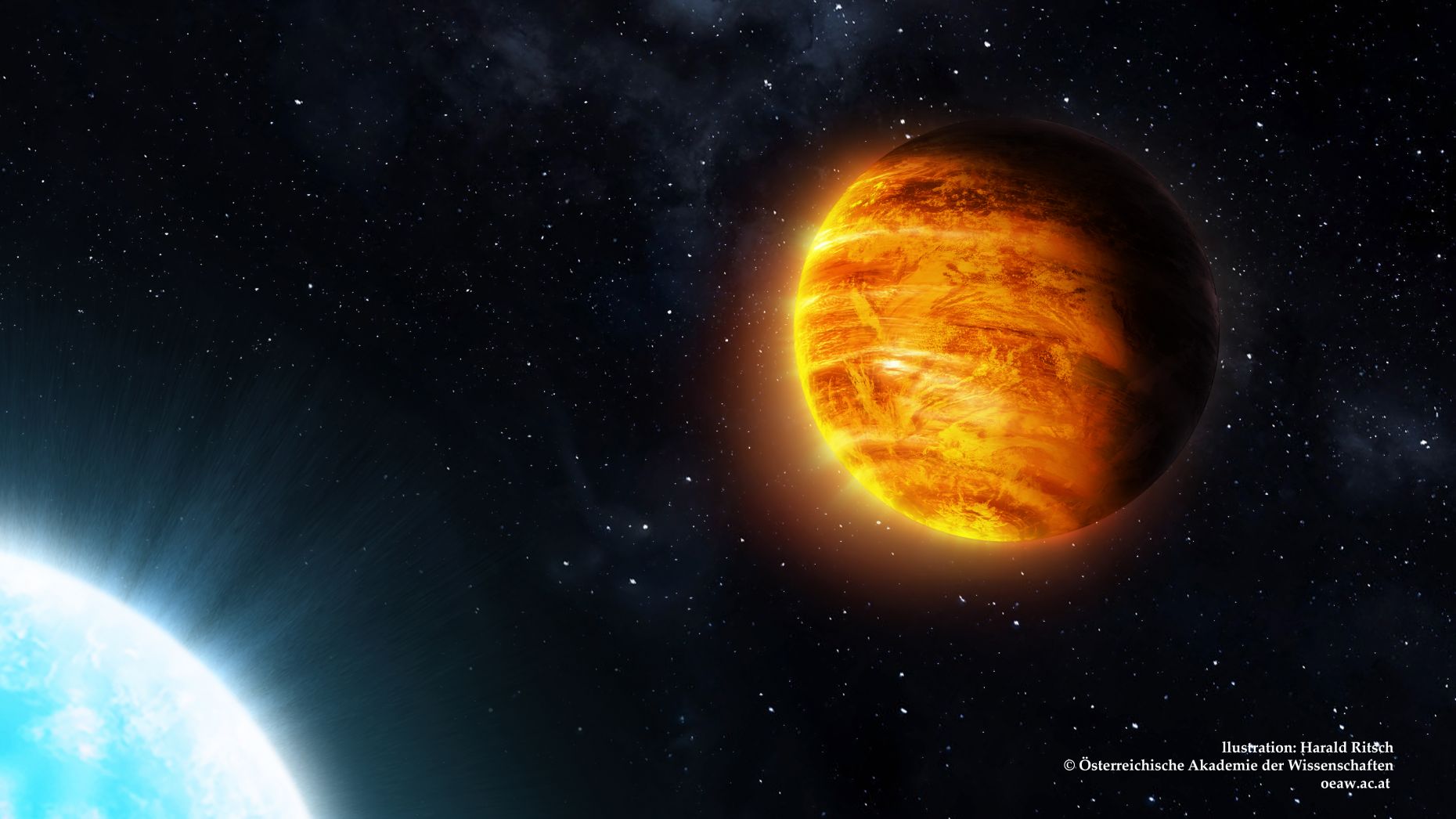Exoplanet KELT-9b: Traces of oxygen detected

Atmosphere of exoplanets
Exoplanets are planets that orbit stars other than the Sun. Since the first extrasolar planets were discovered just over two decades ago, scientists have been trying to characterise their atmospheres and explain why they are so different from the planets in our solar system. To observe the atmospheres of these distant planets, the spectra of the exoplanets are searched for their spectral "fingerprints". "In a so-called transit, the planet passes in front of its parent star as seen from Earth," explains Luca Fossati, IWF group leader and second author of the study. "If the planet has an atmosphere, some of the starlight passes through it, allowing us to study the physical properties and composition of the atmosphere."
Hot, hotter, KELT-9b
Discovered in 2017, exoplanet KELT-9b is located 650 light-years away from us, towards the constellation of Swan. It is a gas giant with 2.8 times the mass of Jupiter, but twice the density. KELT-9b is extremely intensely irradiated by its parent star HD 195689 (Fig. 1 + Fig. 2). Since the planet is very close to the star and always shows the same side to it (like the Moon and Earth), temperatures of over 4000 degrees Celsius are reached on the permanently illuminated hemisphere. Values so high that even tungsten would melt, a metal commonly used in our light bulbs. This is because KELT-9b orbits around its hot and bright parent star in only about 36 hours (video). At such temperatures, elementary molecules like water, carbon dioxide and methane cannot exist, nor can life as we know it. These extreme properties make KELT-9b so interesting. The scientists want to understand the nature of such a hot and strange object and find out why the planet does not simply evaporate near its parent star.
Oxygen is not equal to life
With the aim of better characterising the properties of KELT-9b, the team discovered the "fingerprints" of atomic oxygen in the planet's spectrum. It is the first unequivocal detection of oxygen atoms in the atmosphere of an exoplanet. The idea for the detection came from new simulations of the planet's atmosphere led by Fossati. The researchers have developed a computer model that can simulate the atmospheres of hot exoplanets. With this model, the most important properties of the outermost exoplanet atmospheres can be reproduced on the computer and their structure, composition and temperature can be predicted with unprecedented accuracy. The data obtained from the simulations for KELT-9b not only matched previous observations of other chemical elements - such as hydrogen - in its atmosphere, but also pointed to the possible detection of oxygen atoms, which eventually led the researchers to actually search for them.
The presence of life on KELT-9b is ruled out at the temperatures prevailing on its surface, but the technology and computer models can be used just as effectively to search for oxygen in the atmospheres of more temperate, Earth-like exoplanets.
Simulations match reality
The team analysed previous observations of the planet made with the 3.6-metre telescope at the Calar Alto Observatory in Spain. "Our results confirmed the prediction of the theoretical model: the oxygen traces were present from the beginning, but were missed in previous analyses," Fossati said. The model not only predicted their presence, it also agrees surprisingly well with observations. This gives the researchers confidence that the physics on which the simulations are based represent the reality of hot atmospheres of exoplanets to an unprecedented extent. The results show that although KELT-9b loses some gas from its hot atmosphere over time, it is not in danger of evaporating any time soon. However, its proximity to the star leads to strong turbulence and gale force winds in its atmosphere. Observations indicate that wind speeds can reach up to 40,000 kilometres per hour, which is remarkable considering that the strongest wind speeds measured on Earth are about 400 kilometres per hour and those of Jupiter are about 1,500 kilometres per hour.
Dress rehearsal for future oxygen search
The agreement between the model and the observations is a milestone in the exploration of planets outside the solar system. "We now know that we can create realistic models of exoplanets and understand the atmospheres of the hottest exoplanets much better," Fossati points out. Similar observations of the atmospheres of smaller, cooler planets are not yet possible, but will be one day. "We see this work as a dress rehearsal for future searches for oxygen in the atmospheres of various planets in the galaxy, including smaller, potentially habitable, Earth-like worlds," says the IWF researcher.
Observations by NASA's Transiting Exoplanet Survey Satellite (TESS) have revealed details about KELT-9 b
The video is provided via Youtube , a connection to the servers of Youtube is established (see privacy policy).
Publikation
F. Borsa, L. Fossati, T. Koskinen, M.E. Young, and D. Shulyak: High-resolution detection of neutral oxygen and non-LTE effects in the atmosphere of KELT-9b, Nature Astronomy, doi: 10.1038/s41550-021-01544-4, 2021.

